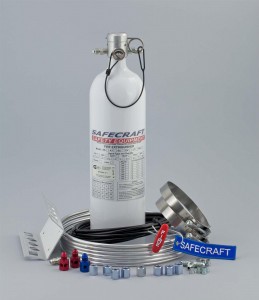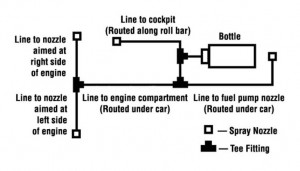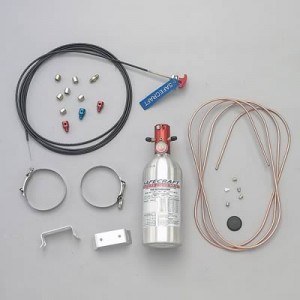 When it comes to race safety, it doesn’t pay to take chances.
When it comes to race safety, it doesn’t pay to take chances.
Stuff like harnesses, roll bar padding, ignition cutoff switches, and fire suppression systems may not be glamorous, but your life may well depend on them. That’s why we’re going to give you some handy tips on how to choose and install a fire suppression system in your race vehicle.
Many race sanctioning bodies require some type of fire suppression system. If yours doesn’t, we’d still recommend you have one if you’re running something faster than a 14-second bracket car.
The key is choosing the right one for your application.
Start by looking at your race sanctioning body and class rules. Are you required to have a fire suppression system on-board? Does it need to be SFI or FIA certified? And what are the specific requirements for mounting, bottle size, and chemical agent type?
Choosing Your Agent
The most widely used agents in fire suppression systems are:
Halon: Halon is stored as a liquid under pressure and discharged as a combination of liquid and gas that flows around obstructions to smother the flame and cool the fire to reduce re-ignition. It is a clear gas, so it can fill the cockpit and suppress a fire without hindering your ability to find your way out. Plus, Halon won’t damage expensive electronics and doesn’t require cleanup under normal circumstances. Halon has been around (seemingly) forever, but is no longer SFI approved.
Dupont FE36: This is DuPont’s SFI-approved replacement for Halon. Unlike Halon, it doesn’t contain any ozone-depleting chemicals and has a lower toxicity than Halon. FE36 offers similar performance to traditional Halon, but it takes quite a bit more FE36 to do the job. For that reason, you may need to use a larger extinguisher bottle compared to a Halon system. Still, many manufacturers are moving to the FE36 agent, which is also friendly to electronics.
AFFF: Popular in Europe and FIA-approved, Aqueous Film Forming Foam is a water-based solution discharged as a soapy foam. AFFF does a good job quenching fires and cooling fuels, but it doesn’t spread out like Halon or FE36. Unfortunately, it also leaves a bigger mess than its counterparts.
Again, check your rulebook for the accepted agent (if specified) in your sanctioning body.
Activation Method
There are three main types of activation options for fire suppression systems:
Push/pull-cable: In this setup, a cable is used to set off the extinguisher. Most systems use a safety pin to prevent accidental activation before installation. The advantage to this setup is its comparatively inexpensive but allows you to mount the push/pull-cable handle where it’s quick and easy to reach.
Push-knob: In this design, the push-knob is mounted right on the extinguisher. These systems also use a safety pin to prevent undesired activation, but don’t give you the mounting flexibility of cable-activated systems. The extinguisher itself must be mounted near the driver.
Electrical: These systems use a triggering switch and an activation box to electronically work the fire extinguisher.
The type of activation setup you use depends largely upon your budget and how involved you want the installation to be.
Ports, Nozzles and System Setup
Many suppression systems, like the ones offered through Safecraft, have two or three discharge ports on the bottle.

A multiple nozzle setup using a bottle with one discharge port. In this configuration, a fourth nozzle is added for added coverage in the engine compartment.
This is so you can route multiple discharge lines and aim the fire suppressant at several locations in your vehicle. In theory, your first consideration should be the driver so you’ll want to route one of the spray nozzles to the driver’s compartment. The second and/or third nozzle should be pointed at the potential sources of fire to actually stop the flames. Ideally, it’s better to have a three-port system so you can route the nozzles to the cockpit (driver), engine compartment, and fuel source (either fuel cell or fuel pump).
That being said, you’ll need more fire suppressant to supply a three-port setup so you’ll likely have to go with a larger bottle. Some companies even recommend a second, smaller bottle just for the driver’s area. Again, your sanctioning body may have rules governing the minimum size of the fire bottle, so you’ll want to consult your rulebook.
Most systems include all the nozzles, fittings, and necessary line to set up your fire suppression system. The type of line that comes in your kit—aluminum or steel—will often depend on the type of racing you do. For example, Safecraft uses aluminum tube for circle track applications, and steel discharge tubes for NHRA/IHRA.
Mounting Tips
- Extinguisher should be mounted horizontally or vertically with head up.
- Mount the extinguisher so you can see the gauge and label, making it easier for tech inspectors.
- When installing a pull-cable activated system, mount the pull handle in the desired location first and then route the cable to the extinguisher.
- Do not crimp tubing when routing—use a tubing bender
Budget can also come into play when considering the type of fire suppression system you use. Be real about your budget and application. Be informed about your race class and sanctioning body. And be ready to race another day with the right fire suppression system.


Comments